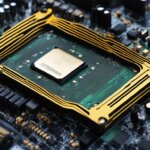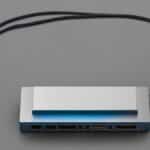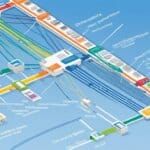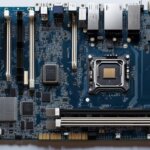Table of Contents
A MAC address (media access control address) is a 12-digit hexadecimal number that serves as a unique identifier for each device connected to a network. It is primarily assigned during device manufacturing and can be found on a device’s network interface card (NIC). The MAC address plays a crucial role in networking devices by facilitating seamless communication between them.
Belonging to the data link layer of the OSI model, the MAC address is used to encapsulate the source and destination MAC addresses in the header of each data frame. This ensures that data is sent to the intended recipient, enabling efficient and reliable communication in networking environments.
Each network interface in a device is assigned a unique MAC address, allowing devices to have multiple MAC addresses if they have multiple network interfaces. This uniqueness ensures that networking devices can identify and communicate with each other effectively, enabling seamless connectivity for users.
How to Find the MAC Address
Finding the MAC address of a device is essential for various purposes, such as configuring a network router, implementing device filtering, or troubleshooting network issues. The process of finding the MAC address may vary depending on the operating system or device you are using.
If you are using a Windows-based machine, you can find the MAC address by following these steps:
- Open the command prompt by pressing the Windows key + R and typing “cmd” in the Run dialog box.
- In the command prompt, type “ipconfig /all” and press Enter.
- Look for the “Physical Address” or “MAC Address” under the network adapter you want to find the MAC address of.
If you are using a Mac, you can find the MAC address by following these steps:
- Go to the System Preferences.
- Select “Network.”
- Choose the network interface for which you want to find the MAC address.
- Click on the “Advanced” button.
- Go to the “Hardware” tab, and you will find the MAC address listed as “MAC Address” or “Ethernet ID.”
On Linux systems, finding the MAC address can be done through the terminal by typing “ifconfig” and looking for the “HWaddr” or “ether” address associated with the desired network interface.
For mobile devices like iPhones and Android phones, the process of finding the MAC address may vary depending on the device’s operating system version. Generally, it can be found in the device settings under the Wi-Fi or About sections.
Finding the MAC address is a crucial step when it comes to network troubleshooting, device configuration, or network router management. By knowing the MAC address of your devices, you can ensure seamless connectivity and efficient network management.
Why is Finding the MAC Address Important?
Knowing the MAC address of a device allows network administrators to identify and manage devices on a network more effectively. It is particularly useful when configuring network routers, implementing device filtering, or troubleshooting network connectivity issues. By having the MAC address, administrators can easily grant or restrict access to specific devices and ensure the security and stability of the network.
Types of MAC Addresses
MAC addresses come in different types, serving specific purposes in network communication. Let’s explore the three main types:
1. Unicast MAC Address
A unicast MAC address is unique to a specific network interface card (NIC) and facilitates communication between a single transmitting device and a single destination device. It ensures direct, point-to-point communication in a network.
2. Multicast MAC Address
A multicast MAC address allows a source device to transmit data frames to multiple devices that belong to a multicast group. This type of address is used when a message needs to be sent to a specific group of devices simultaneously.
3. Broadcast MAC Address
A broadcast MAC address represents every device on a given network and is used for broadcasting data to all devices on that network. When a device sends data to a broadcast MAC address, it is transmitted to all devices connected to the network.
Understanding these MAC address types is crucial in comprehending how network devices communicate and share data efficiently.

Stay tuned for the next section where we will delve into the differences between MAC addresses and IP addresses, two essential components in device identification and network communication.
MAC Address vs. IP Address
Both MAC addresses and IP addresses play a crucial role in device identification and network communication. While they serve a similar purpose, there are fundamental differences between the two.
An MAC address, also known as a media access control address, is a unique identifier that is permanently assigned to a device during the manufacturing process. It is hardcoded into the device’s hardware, typically on the network interface card (NIC). The MAC address is used for local scale identification, allowing devices to communicate within a specific network. It resides at Layer 2 of the OSI or TCP/IP reference model.
On the other hand, an IP address is assigned to a device’s network connection by a network administrator or internet service provider (ISP). The IP address identifies devices globally or through their internet address and enables network communication on a global scale. It resides at Layer 3, also known as the network layer, of the TCP/IP or OSI model.
While MAC addresses are unique to each device and do not change, IP addresses can be dynamically assigned or static depending on the network configuration. This flexibility allows IP addresses to be reconfigured, reassigned, or changed altogether.
Here is a comparison between MAC addresses and IP addresses:
| MAC Address | IP Address |
|---|---|
| Unique identifier hardcoded into the device hardware | Assigned to a device’s network connection |
| Used for local scale identification | Enables global network communication |
| Resides at Layer 2 of the OSI or TCP/IP model | Resides at Layer 3 of the TCP/IP or OSI model |
| Permanent and does not change | Can be dynamically assigned or static |
In summary, MAC addresses and IP addresses serve distinct purposes in device identification and network communication. While MAC addresses are unique hardware identifiers used for local scale communication, IP addresses enable global network connectivity and can be assigned or changed dynamically. Understanding the differences between these two types of addresses is crucial for effective network management and troubleshooting.
MAC Address Structure
In order to understand MAC addresses better, it’s essential to grasp their specific structure. A MAC address is a 48-bit address that consists of six groups of two hexadecimal digits. These groups are separated by colons or hyphens for better readability. The structure of a MAC address can be visualized as follows:
| Group | Description |
|---|---|
| 1-2 | Manufacturer’s OUI |
| 3-4 | Organization-specific identifier |
| 5-6 | Device-specific identifier |
The first three groups represent the organizationally unique identifier (OUI), which is assigned by the device manufacturer and identifies the organization. The remaining three groups represent the extended unique identifier (EUI), which is assigned by the organization. There are two numbering spaces based on EUIs managed by the Institute of Electrical and Electronics Engineers (IEEE): EUI-48 and EUI-64.
EUI-48, also known as MAC-48, is used for Ethernet-based networking applications. On the other hand, EUI-64 is utilized for other networking devices and software, such as Bluetooth.
Here’s an example of a MAC address structure:
00:1A:2B:3C:4D:5E
In this example, the first three digits (00:1A:2B) represent the OUI, while the last three digits (3C:4D:5E) represent the EUI.
By understanding the structure of a MAC address, it becomes easier to decode and analyze various components of the address, enabling efficient device identification and maintenance in network management.
MAC Address Administration
In the realm of MAC addresses, administration plays a vital role in ensuring effective network management and device identification. Let’s explore the different aspects of MAC address administration, including burned-in addresses, locally administered addresses, and universally administered addresses.
Burned-in Address
A MAC address, also known as a burned-in address, is assigned to a device during its manufacturing process. This unique identifier is stored in the device’s hardware or firmware, making it an integral part of the device itself. Burned-in addresses are typically unchangeable and serve as a permanent identifier for the device.
Locally Administered Address
A locally administered address is an alternative MAC address that can be assigned to a device by a network administrator or through software configuration. This address overrides the burned-in address and provides the flexibility to modify the MAC address without requiring hardware changes. Locally administered addresses are often used for network testing, privacy protection, or to avoid conflicts within a local network.
Universally Administered Address
On the other hand, a universally administered address is assigned by the device manufacturer and remains unique to each device. These addresses include an organizationally unique identifier (OUI), which represents the manufacturer or organization, along with the remaining digits that serve as the device’s unique identifier. Universally administered addresses ensure global uniqueness and facilitate efficient device identification on networks.
Understanding the distinction between burned-in addresses, locally administered addresses, and universally administered addresses is crucial for effective MAC address administration. It enables network administrators to manage and allocate addresses efficiently, ensuring seamless communication and device identification within local and global networks.
MAC Address Security and Privacy
When it comes to MAC address security and privacy, it is important to consider certain factors. In IPv4, MAC addresses are limited to the local network and cannot be used to track devices over the internet. They do not propagate or detect beyond the local network. However, in IPv6, the MAC address may be visible to servers due to the automatic generation of the 64-bit host part of the address from the MAC address.
This visibility can potentially allow outsiders to trace the MAC address of routers and internet-connected devices. This is why it is essential to ensure proper security measures to protect your network and devices. One concern is MAC address spoofing, which refers to the act of changing the MAC address to mask the device’s true identity. Although MAC spoofing is possible on most hardware, it is limited to the local network.
It is crucial to note that Internet Service Providers (ISPs) can still trace devices and their activities, unless the network traffic is encrypted using a Virtual Private Network (VPN). Implementing a VPN can provide an additional layer of security by encrypting your traffic and masking your device’s identity, making it difficult for ISPs and outsiders to track or trace your activities.
FAQ
What is a MAC address?
A MAC address, also known as a media access control address, is a 12-digit hexadecimal number that serves as a unique identifier for each device connected to a network. It is primarily assigned during device manufacturing and can be found on a device’s network interface card (NIC).
How can I find the MAC address of a device?
The process for finding the MAC address varies depending on the operating system or device. On Windows-based machines, it can be found using the command prompt or through the network settings and status. On a Mac, it can be found in the System Preferences under Network. On Linux, the MAC address can be obtained by typing “ifconfig” in the terminal. The process for finding the MAC address on mobile devices like iPhone and Android varies, but it can usually be found in the device settings.
What are the different types of MAC addresses?
There are three types of MAC addresses: unicast, multicast, and broadcast. A unicast MAC address is used for communication between a single transmitting device and a single destination device. A multicast MAC address allows a source device to transmit data frames to multiple devices belonging to a multicast group. A broadcast MAC address represents every device on a network and is used for broadcasting data to all devices on the network.
How does a MAC address differ from an IP address?
While both MAC addresses and IP addresses identify devices on a network, they differ in their scope and function. A MAC address is a unique hardware identifier assigned during manufacturing, used to identify devices on a local scale. An IP address, on the other hand, is assigned to a network connection by a network administrator or ISP, used to identify devices globally or through their internet address.
What is the structure of a MAC address?
A MAC address is a 48-bit address represented by six groups of two hexadecimal digits. The first three groups represent the organizationally unique identifier (OUI), assigned by the device manufacturer. The remaining three groups represent the extended unique identifier (EUI) assigned by the organization. There are two numbering spaces based on EUIs managed by the Institute of Electrical and Electronics Engineers (IEEE): EUI-48 and EUI-64.
How is MAC address administration carried out?
MAC addresses are primarily assigned by device manufacturers and are often referred to as burned-in addresses, Ethernet hardware addresses, or physical addresses. These addresses are usually stored in the device’s hardware or firmware. A MAC address can be either a locally administered address or a universally administered address. A locally administered address is assigned by software or a network administrator, overriding the burned-in address. A universally administered address is uniquely assigned to a device by its manufacturer and includes the organizationally unique identifier (OUI).
What are the security and privacy considerations regarding MAC addresses?
MAC addresses are not propagated or detectable beyond a local network in IPv4, meaning they cannot be used to track devices over the internet. However, in IPv6, the MAC address may be visible to servers due to the automatic generation of the 64-bit host part of the address from the MAC address. This can potentially allow outsiders to trace the MAC address of routers and internet-connected devices. MAC spoofing, the act of changing the MAC address, is possible on most hardware but is limited to the local network. ISPs can still trace devices and their activities, unless the traffic is encrypted using a VPN.












